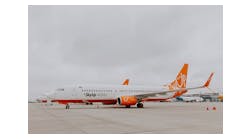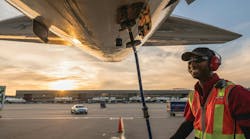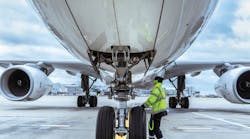Mar. 30—Alaska Airlines is doubling down on its investment in the in-state cargo business and getting back to $50 million of work in the state that was shelved in early 2020, according to airline leaders.
Regional Vice President Marilyn Romano said what Alaska Airlines' once dubbed as its "2020 Great Land Investment Plan" has been rebranded for 2025. The $50 million will go into upgrading and expanding the rest of the 12 terminal facilities Alaska owns and operates across the state that didn't get attention — or enough of it — before the pandemic set in.
The work was about half done before it stopped, according to Romano, with most of the Southeast terminals complete. Alaska now plans to focus on its recently acquired Bristol Bay terminals as well as others in Western and Northern Alaska. The airline's terminal in Kodiak, which received a remodel, is now in need of an expansion, she added.
"We pretty much paused everything we were doing to concentrate on how we were going to get through 2020," Romano said. "We really want people to know we haven't forgotten about our commitments."
A large part of Alaska Airlines' 2020 investment plan was dedicated to the company's now-complete $50 million hangar at Ted Stevens Anchorage International Airport.
As for the other part of Alaska's in-state business, Alaska Air Group executives announced during a March 24 investor presentation that they plan to convert two of the company's Boeing 737-800 passenger aircraft to freighters that will be dedicated to the state of Alaska.
Those two freighters will add to Alaska's existing in-state fleet of three Boeing 373-700 cargo jets, though the larger 737-800s, with approximately 50,000 pounds of payload capacity, will nearly double the fleet's effective cargo capacity.
The 737-800s are likely to arrive in Alaska after a lengthy conversion process sometime in 2023.
"We'll have to wait a while but we know they're coming," Romano said. "It's just great to get back talking about our future versus talking about the pandemic.
Other in-state cargo carriers are watching what Alaska Airlines does closely, according to aviation industry leaders, who said it can be difficult for the smaller operators to compete with the relative giant in the market. However, they also note that disruptions in the Alaska aviation caused by the pandemic and the desire to reduce backlogs in the U.S. Postal Service's Bypass Mail program could offer growth potential without significantly squeezing some other carriers.
University of Alaska Anchorage Logistics Professor Darren Prokop suggested via email that inflation could be playing a role in the growth of the state's air cargo market as well.
"If e-commerce items are trending upward in cost to comsumers, and Alaska Airlines is bringing more cargo capacity online, the cost of moving a given pound of cargo may not rise as fast as the price tag of the e-commerce item itself. So, these items might 'appear' more affordable in the midst of general price inflation expected over the medium term," Prokop wrote.
Adam Drouhard, managing director of Alaska Air Cargo, said in an interview that demand in the broader domestic cargo market is up nearly 20% since the start of the pandemic and the trend is starting to reach Alaska.
"There is competition in a number of (in-state) markets, but as we see it there's quite a bit of opportunity for growth," Drouhard said, adding that the airline saw demand grow shortly after it added the three 737-700s in 2018.
"You can actually stimulate demand of the service" by adding capacity, he said.
To that end, the 18 to 20 locations in-state locations Alaska now serves with summer cargo service have mostly taken what the current fleet can offer.
"Doing that with three planes — we're pushing them to their limits," Drouhard said.
"We just want to make sure we have the right mix of aircraft and provide benefits to the places we serve."
New Horizon hub
Horizon Air, Alaska's sister regional carrier, will be opening an Anchorage base for pilots and flight attendants in the coming days, a move Romano said should help curb an increase in Horizon flight cancellations in the state due to a lack of available pilots.
Horizon began flying its smaller Embraer E175 jets on flights marketed by Alaska Airlines between Anchorage and Fairbanks and Bristol Bay communities in the fall of 2020. Officials at those airports said there has been a spike Alaska-Horizon flight cancellations in recent weeks but referred questions about the specific number of pilot shortage-induced cancellations to airline representatives.
Romano said there have "definitely been more (cancellations) than we would have wanted," but added that Alaska has begun backfilling some cancelled E175 flights with larger 737s in an attempt to make up for lost capacity.
Upwards of 75 people could eventually work out of Horizon's new Alaska base, she said.
"I think it's going to help tremendously having people who live and work here. We'll build it up to match the increase in flying," she said.
Romano emphasized the pilot shortage is nationwide and particularly impacting regional carriers that are trying to rebuild their flight schedules following the fallout from the pandemic.
Pilots for regional carriers are often hired away by major mainline carriers and there simply are not enough new pilots entering the proverbial pipeline to keep aircraft staffed. It's an issue that has long plagued the countless in-state flight services and small airlines, but is now working its way up the industry.
Elwood Brehmer can be reached at [email protected].
___
(c)2022 the Alaska Journal of Commerce (Anchorage, Alaska)
Visit the Alaska Journal of Commerce (Anchorage, Alaska) at www.alaskajournal.com
Distributed by Tribune Content Agency, LLC.



